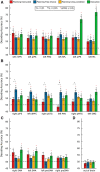Decoding Internally and Externally Driven Movement Plans
- PMID: 26490857
- PMCID: PMC6605426
- DOI: 10.1523/JNEUROSCI.0596-15.2015
Decoding Internally and Externally Driven Movement Plans
Abstract
During movement planning, brain activity within parietofrontal networks encodes information about upcoming actions that can be driven either externally (e.g., by a sensory cue) or internally (i.e., by a choice/decision). Here we used multivariate pattern analysis (MVPA) of fMRI data to distinguish between areas that represent (1) abstract movement plans that generalize across the way in which these were driven, (2) internally driven movement plans, or (3) externally driven movement plans. In a delayed-movement paradigm, human volunteers were asked to plan and execute three types of nonvisually guided right-handed reaching movements toward a central target object: using a precision grip, a power grip, or touching the object without hand preshaping. On separate blocks of trials, movements were either instructed via color cues (Instructed condition), or chosen by the participant (Free-Choice condition). Using ROI-based and whole-brain searchlight-based MVPA, we found abstract representations of planned movements that generalize across the way these movements are selected (internally vs externally driven) in parietal cortex, dorsal premotor cortex, and primary motor cortex contralateral to the acting hand. In addition, we revealed representations specific for internally driven movement plans in contralateral ventral premotor cortex, dorsolateral prefrontal cortex, supramarginal gyrus, and in ipsilateral posterior parietotemporal regions, suggesting that these regions are recruited during movement selection. Finally, we observed representations of externally driven movement plans in bilateral supplementary motor cortex and a similar trend in presupplementary motor cortex, suggesting a role in stimulus-response mapping.
Significance statement: The way the human brain prepares the body for action constitutes an essential part of our ability to interact with our environment. Previous studies demonstrated that patterns of neuronal activity encode upcoming movements. Here we used multivariate pattern analysis of human fMRI data to distinguish between brain regions containing movement plans for instructed (externally driven) movements, areas involved in movement selection (internally driven), and areas containing abstract movement plans that are invariant to the way these were generated (i.e., that generalize across externally and internally driven movement plans). Our findings extend our understanding of the neural basis of movement planning and have the potential to contribute to the development of brain-controlled neural prosthetic devices.
Keywords: MVPA; decoding; fMRI; free choice; movement planning; movement selection.
Copyright © 2015 the authors 0270-6474/15/3514160-12$15.00/0.
Figures






Similar articles
-
Where one hand meets the other: limb-specific and action-dependent movement plans decoded from preparatory signals in single human frontoparietal brain areas.J Neurosci. 2013 Jan 30;33(5):1991-2008. doi: 10.1523/JNEUROSCI.0541-12.2013. J Neurosci. 2013. PMID: 23365237 Free PMC article.
-
Effector selection precedes reach planning in the dorsal parietofrontal cortex.J Neurophysiol. 2012 Jul;108(1):57-68. doi: 10.1152/jn.00011.2012. Epub 2012 Mar 28. J Neurophysiol. 2012. PMID: 22457458 Free PMC article.
-
Decoding grip type and action goal during the observation of reaching-grasping actions: A multivariate fMRI study.Neuroimage. 2021 Nov;243:118511. doi: 10.1016/j.neuroimage.2021.118511. Epub 2021 Aug 24. Neuroimage. 2021. PMID: 34450263
-
Elucidating the neural circuitry underlying planning of internally-guided voluntary action.J Neurophysiol. 2016 Dec 1;116(6):2469-2472. doi: 10.1152/jn.00068.2016. Epub 2016 Apr 27. J Neurophysiol. 2016. PMID: 27121575 Free PMC article. Review.
-
fMRI studies of eye movement control: investigating the interaction of cognitive and sensorimotor brain systems.Neuroimage. 2007;36 Suppl 2(Suppl 2):T54-60. doi: 10.1016/j.neuroimage.2007.03.018. Epub 2007 Mar 27. Neuroimage. 2007. PMID: 17499170 Free PMC article. Review.
Cited by
-
Decoding Parametric Grip-Force Anticipation From fMRI Data.Hum Brain Mapp. 2025 Feb 15;46(3):e70154. doi: 10.1002/hbm.70154. Hum Brain Mapp. 2025. PMID: 39936353 Free PMC article.
-
Selective Modulation of Early Visual Cortical Activity by Movement Intention.Cereb Cortex. 2019 Dec 17;29(11):4662-4678. doi: 10.1093/cercor/bhy345. Cereb Cortex. 2019. PMID: 30668674 Free PMC article.
-
Evidence for an effector-independent action system from people born without hands.Proc Natl Acad Sci U S A. 2020 Nov 10;117(45):28433-28441. doi: 10.1073/pnas.2017789117. Epub 2020 Oct 26. Proc Natl Acad Sci U S A. 2020. PMID: 33106395 Free PMC article.
-
A preliminary study of longitudinal neuroadaptation associated with recovery from addiction.Drug Alcohol Depend. 2016 Nov 1;168:52-60. doi: 10.1016/j.drugalcdep.2016.08.626. Epub 2016 Sep 9. Drug Alcohol Depend. 2016. PMID: 27620345 Free PMC article.
-
The Cortical and Subcortical Neural Control of Swallowing: A Narrative Review.Dysphagia. 2024 Apr;39(2):177-197. doi: 10.1007/s00455-023-10613-x. Epub 2023 Aug 21. Dysphagia. 2024. PMID: 37603047 Review.
References
Publication types
MeSH terms
Substances
LinkOut - more resources
Full Text Sources
